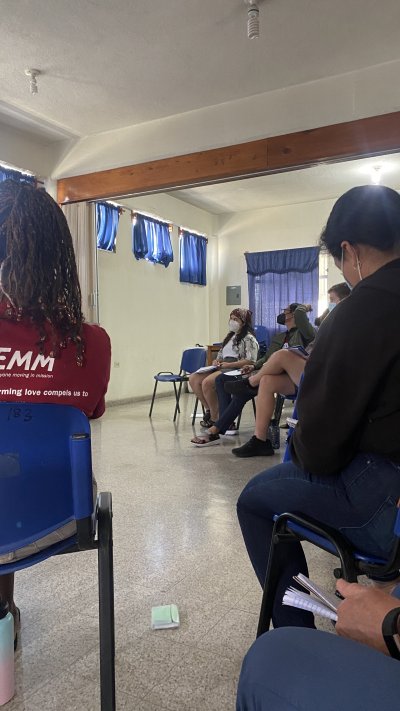Guatemalan History & UPAVIM
We opened this Wednesday off with Cesar Garcia returning as our guest speaker to continue our discussion on various topics related to Guatemalan history. The first note made by Garcia was a comparison of the origin and meaning of the name Guatemala. For instance, Wikipedia claims that the name “Guatemala” comes from the Nahuatl word: Cuauhtēmallān (Nahwiki) which translates to “place of many trees”. According to Garcia, “Quauhtemallan” literally translates to “Place of the breadnut tree” or (Brosimum alicasrtum) known in Kagchikal as Ixmiche (literally, tree of corn).
After covering the origin of Guatemala’s namesake, we discussed a variety of issues stemming from Guatemala’s independence from Spain in 1821, the development of the constitutional democratic republic in 1847, to how elections have been historically marketed towards the rich rather than the general public. A consistent topic within today’s session was the corruption that has plagued the Guatemalan government, from systemic issues such as undercutting governmental programs to political figures being involved with narcos. There were also notes on how indigenous people have struggled to preserve their culture in a ladino-centric state. Although these problems are quite evident within Guatemala, there are still reasons to be optimistic for the future. Garcia stressed a cultural revolution in which young people and women are adding new political factors to the current system. They seem to represent a newfound sense of change that approaches Guatemalan culture and the political spectrum.
After our more ambitious trip to the Terminal Market and Puerta de Esperanza yesterday, we visited UPAVIM this afternoon. UPAVIM (United for a Better Life) is a women’s cooperative located within a “Red Zone” on the edge of Guatemala City. La Esperanza, the location of UPAVIM, is plagued by violence and the presence of gangs. Despite this, UPAVIM provides an opportunity to economically empower women and their families. While speaking with two women from the cooperative, we learned that UPAVIM not only provides these opportunities for women who frequent La Esperanza, but also serves as a bakery, school, and medical clinic. The school in particular has begun offering Montessori education to its students. Although the Montessori addition is quite new, the cooperative is hopeful to continue with this style of education for its classes. After our students had asked a number of questions, they were able to buy from a selection of crafts handmade by the women at UPAVIM. There was a wide range of things to purchase from lanyards and scrunchies to ornaments and aprons. Handmade items from UPAVIM are frequently sold within the US at fair trade places, including Ten Thousand Villages. To check out more about the cooperative, see their website for a description of their work and handmade products.
Before leaving UPAVIM we checked out the bakery that lies beneath the cooperative. To get there, we made our way out through the main entrance and turned a sharp corner to find the bakery window. The scent of freshly baked bread wafted out of the street window and filled the air with a sweet aroma. Naturally, our students became fairly hungry after smelling something so delicious. It’s safe to say that each student bought at least one piece of bread from the bakery, costing each person around one Quetzal for three pieces of bread. After taking a beat to enjoy the buttery snack, we thanked the workers at UPAVIM and left for SEMILLA.
Upon returning back to CASAS, our students had some free time to play table tennis, write in their journals, or just hang out on campus. (program assistants Alex, Jahari, and Greta laid down for a well-deserved nap). After the post-cooperative activities and dinner, we settled down for another student-led worship service. Lucca, Nicholas, Eva, and Soleil came prepared with hymnal songs, prayers, and an identity exercise. The identity exercise called for each of us to bring an object that was special to us or represented a certain aspect of our identities. Some of the objects in tonight’s exercise included: an angry bird hacky sack, chess pieces, dance shoes, and even a Pythagorean cup. Along with the object, some students dove deeper into the exercise and described the significance that the object had in their lives. Some students had their objects in possession for years, while others had certain memories attached to theirs. The exercise allowed each student to share an intimate aspect of their lives and open up conversations pertaining to their identities.
The liminal space we’ve entered also has allowed students to think about their callings, commitments, and passions, and that’s one of the goals of the program. In yesterday’s journal about Puerta de Esperanza, Eva wrote (cited with her permission) that it had struck her that this is what she wants to do: “I want to make a difference, meet these people, hear their stories, and write them for the world to hear …My Dad told me the trip would change me, that I would see the world in a completely different way just as he did as an 18-year-old in Colombia. I want to be a part of their stories but more than that I want the people to be a part of mine. When I called my parents I told them that nothing in life had confused me while also clearing all the confusion of my life … Yesterday was like no other day in my life and I won’t ever forget it. Guatemala is changing me and I am glad it is. I’ve never felt more like myself in a while.”
Although originally planned for today, our trip to Cayala Mall has been rescheduled for tomorrow. The contrast tour, as mentioned yesterday, will provide a radical contrast to what we’ve observed so far, such as the Terminal Market. After we check out Cayala Mall, we have a volunteer activity tomorrow that will be sure to keep our students creatively engaged. Check back in tomorrow to hear what journeys await our SSTT Scholars.
-Alexander Koscher











































































